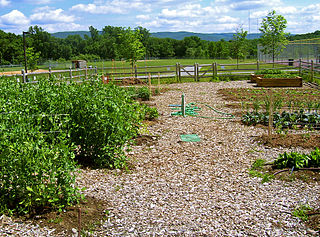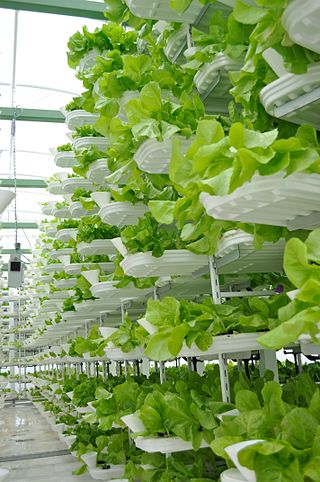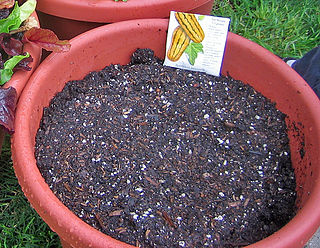This article contains promotional content .(November 2018) |
The Rooftop Garden Project is an experimental urban gardening project in Montreal, Canada. [1]
This article contains promotional content .(November 2018) |
The Rooftop Garden Project is an experimental urban gardening project in Montreal, Canada. [1]
The concept of soil-less method planting was introduced by the Montreal-based group Alternatives in 2001. Peggy Bradley, an American researcher, was developing soil-less techniques aimed at offering low-cost, ecologically sustainable, and low-tech gardening solutions for poor, rural communities in regions such as Brazil. Observing the efforts of the Institute for Simplified Hydroponics in Tehuacán, Mexico, Alternatives representatives also took interest in similar initiatives in Morocco and India.
In 2001, the Institute for Simplified Hydroponics extended its initiatives to Montreal. Jane Rabinowicz of Santropol Roulant and Ishmael Hautecoeur of Alternatives collaborated to create what became known as the Rooftop Garden Project. A demonstration garden of 500m² was established on a rooftop near Burnside Hall on the McGill University campus. By 2006, Santropol Roulant was able to produce one-third (or one ton) of the food used in its program through this garden.
The Rooftop Garden Project aims to promote local food production within the Montreal area. It has established community gardens in various locations, including social housing complexes, schools, seniors' residences, and urban spaces such as rooftops, balconies, and stairwells. The Project also undertakes educational initiatives to raise awareness about the sustainability and affordability of autonomous food production. These programs are offered in schools and universities, encouraging local communities and organizations to engage in food growing practices.
Soil-less Cultivation Process
The soil-less cultivation process used by the Rooftop Garden Project involves self-watering containers that are portable and adaptable to various environments. These containers are typically made from recycled materials and are designed to be simple to construct. In 2002, Alternatives converted a 50-gallon olive barrel into a rooftop planting container. Other items, such as tires and storage bins, can also be repurposed for this use. The containers are lined with materials like sawdust or vermiculite to help absorb nutrients and moisture. Organic compost, including vegetable scraps and coffee grounds, provides nutrients to the plants. The containers are watered by rain or simple irrigation systems, keeping the roots moist while allowing for periodic airing to prevent crop damage. Produce like cucumbers, tomatoes, basil, lettuce, and other crops that require minimal space thrive in these environments.
Garden Organization
The initial demonstration garden was managed by volunteers and staff. Over time, the initiative has led to the creation of autonomous gardens operated by enterprises and local communities, with both personal and collective gardens. In Montreal, soil-less garden containers are commonly seen in various urban spaces.
The Project’s first hydroponic system was eventually revised and replaced with a semi-hydroponic system. This new approach eliminated the chemical components of the original system in favor of a self-watering design that uses compost for nutrients and soil for irrigation. This system is considered to be more sustainable, cost-effective, and organic.
Volunteering and Funding
Initially, volunteers for the Rooftop Garden Project were primarily young adults and students, leading to high turnover rates. Over time, the volunteer base became more stable, which strengthened relationships with external partners. Several Montreal universities, including Concordia University, have contributed to the project, with Concordia running a project in its greenhouse.
The majority of the Rooftop Garden Project's funding is provided by Alternatives, with additional support from institutions such as McGill University, UQAM, TelUQ, and Engineers Without Borders. While Santropol Roulant, a volunteer and donation-run organization, does not have the resources to fund and expand the Project, the Rooftop Garden Project also relies on donations and community fundraising efforts. Local organizations, such as Action Comuniterre’s collective garden in the NDG borough of Montreal, have also supported the Project through activities like selling organic heritage seeds and plants.

Hydroponics is a type of horticulture and a subset of hydroculture which involves growing plants, usually crops or medicinal plants, without soil, by using water-based mineral nutrient solutions in an artificial environment. Terrestrial or aquatic plants may grow freely with their roots exposed to the nutritious liquid or the roots may be mechanically supported by an inert medium such as perlite, gravel, or other substrates.

The following outline is provided as an overview of and topical guide to organic gardening and farming:

A roof garden is a garden on the roof of a building. Besides the decorative benefit, roof plantings may provide food, temperature control, hydrological benefits, architectural enhancement, habitats or corridors for wildlife, recreational opportunities, and in large scale it may even have ecological benefits. The practice of cultivating food on the rooftop of buildings is sometimes referred to as rooftop farming. Rooftop farming is usually done using green roof, hydroponics, aeroponics or air-dynaponics systems or container gardens.

Urban agriculture refers to various practices of cultivating, processing, and distributing food in urban areas. The term also applies to the area activities of animal husbandry, aquaculture, beekeeping, and horticulture in an urban context. Urban agriculture is distinguished from peri-urban agriculture, which takes place in rural areas at the edge of suburbs.

Aquaponics is a food production system that couples aquaculture with hydroponics whereby the nutrient-rich aquaculture water is fed to hydroponically grown plants.
Urban gardening is the practice of growing vegetables, fruit and plants in urban areas, such as schools, backyards or apartment balconies.

Organopónicos or organoponics is a system of urban agriculture using organic gardens. It originated in Cuba and is still mostly focused there. It often consists of low-level concrete walls filled with organic matter and soil, with lines of drip irrigation laid on the surface of the growing media. Organopónicos is a labour-intensive form of local agriculture.

Vertical farming is the practice of growing crops in vertically and horizontally stacked layers. It often incorporates controlled-environment agriculture, which aims to optimize plant growth, and soilless farming techniques such as hydroponics, aquaponics, and aeroponics. Some common choices of structures to house vertical farming systems include buildings, shipping containers, underground tunnels, and abandoned mine shafts.
This is an alphabetical index of articles related to gardening.
Founded in 1994, Alternatives, Action and Communication Network for International Development, is a non-governmental, international solidarity organization based in Montreal, Quebec, Canada.

Green waste, also known as "biological waste", is any organic waste that can be composted. It is most usually composed of refuse from gardens such as grass clippings or leaves, and domestic or industrial kitchen wastes. Green waste does not include things such as dried leaves, pine straw, or hay. Such materials are rich in carbon and considered "brown wastes," while green wastes contain high concentrations of nitrogen. Green waste can be used to increase the efficiency of many composting operations and can be added to soil to sustain local nutrient cycling.

Potting soil or growing media, also known as potting mix or potting compost (UK), is a substrate used to grow plants in containers. The first recorded use of the term is from an 1861 issue of the American Agriculturist. Despite its name, little or no soil is usually used in potting soil.
Building-integrated agriculture (BIA) is the practice of locating high-performance hydroponic greenhouse farming systems on and in mixed-use buildings to exploit synergies between the built environment and agriculture.
Organic hydroponics is a hydroponics culture system based on organic agriculture concepts that does not use synthetic inputs such as fertilizers or pesticides. In organic hydroponics, nutrient solutions are derived from plant and animal material or naturally mined substances. Most studies on the topic have focused on the use of organic fertilizer.
There are many ways to garden in restricted spaces. Often a small or limited space is an issue in growing and cultivating plants. Restricted space gardens can be located on small lawns, balconies, patios, porches, rooftops, inside the home, or in any other available place. Gardening in small places can be applied to edible or floral plants. Growing food has many benefits including saving money; healthier, fresher, and better tasting food; knowledge of pesticide and fertilizer exposure. Gardening is a good form of exercise and has been proven to be therapeutic.
New York Sun Works, founded in 2004 by Ted Caplow, is a 501(c)(3) non-profit organization that uses hydroponic farming technology to educate students and teachers about the science of sustainability. Their Hydroponic Classroom program was inspired by NY Sun Works' first project, the renowned Science Barge, a prototype sustainable urban farm and environmental education center previously docked on the Hudson River and now located in Yonkers under different ownership.

Lufa Farms is an urban agricultural company located in the Ville Saint-Laurent neighborhood of Montreal, Quebec. The company states its mission is to grow food where people live and grow it more sustainably. The company, founded in 2009, has installed commercial greenhouses on the rooftops of several large industrial buildings in the greater Montreal area.
Vermiponics is a soil-less growing technique that combines hydroponics with vermiculture by utilizing diluted wormbin leachate as the nutrient solution as opposed to the use of fish waste or the addition of manufactured chemicals to provide the nutrients.

The Sustainable Technology Optimization Research Center (STORC) is a research facility located on the California State University Sacramento campus. There are several players included in operations at the STORC including Sacramento State's Risk Management, the College of Engineering and Computer Science (ECS), and two professors in the Environmental Studies department Brook Murphy and Dudley Burton. The STORC facility is primarily maintained by California State University, Sacramento student interns and volunteers who use applied science and technology to address real world policy, food, health, and energy issues of present-day society. Research at the STORC encompasses engineering and science to test and evaluate new ideas and approaches of sustainable technology to solve environmental problems. Faculty and students address sustainability with an interdisciplinary studies approach. The STORC Vision is to become "an international resource for practical, scalable, and financially viable solutions in the area of sustainable technologies that are suitable for private and/or public sector operations related to the management of energy, food, water, and waste". The STORC Mission is "to demonstrate the operation of innovative commercially viable physical systems that are underpinned by sustainable technologies, and to disseminate the associated plans, public policy discourse, and scientific findings".
Urban agriculture is the practice of cultivating, processing, and distributing food in or around urban areas. It is the growing of fresh produce within the city for individual, communal, or commercial purposes in cities in both developed and developing countries.
Beaudin, Monique. “Urban gardening is looking up; Rooftop plots are just one way to 'green' city spaces.” The Montreal Gazette, February 9, 2009. Accessed on April 19, 2010.
Canadian Partnerships; Special Initiatives Programme. Urban Agriculture Reaches New Heights through Rooftop Gardening. Accessed on March 3, 2010.
Granger, Lia. “Urban Gardening: the greenhouse effect.” The Montreal Gazette, April 9. 2010. Accessed on April 19, 2010.
International Partnership in Community Economic Development: The Rooftop Garden Project. Accessed on March 3, 2010.